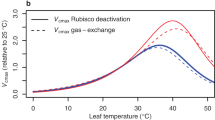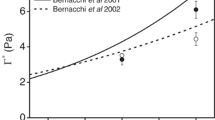Abstract
Increases in growth temperature have been observed to affect photosynthesis differently under long-term exposure to ambient- and twice ambient-air CO2 concentrations. This study investigates the causes of this interaction in wheat (Triticum aestivum L.) grown in the field over two consecutive years under temperature gradient chambers in ambient (370 μmol mol−1) or elevated (700 μmol mol−1) atmospheric CO2 concentrations and at ambient or ambient +4°C temperatures, with either a low or a high nitrogen supply. The photosynthesis-internal CO2 response curves and the activity, activation state, kcat and amount of Ribulose-1, 5-bisphosphate carboxylase/oxygenase (Rubisco) were measured, as well as the soluble protein concentration in flag leaves at ear emergence and 8–15 days after anthesis. A high nitrogen supply increased Vcmax, the Rubisco amount and activity and soluble protein contents, but did not significantly change the Rubisco kcat. Both elevated CO2 and above ambient temperatures had negative effects on Vcmax and Rubisco activity, but at elevated CO2, an increase in temperature did not decrease Vcmax or Rubisco activity in relation to ambient temperature. The amounts of Rubisco and soluble protein decreased with elevated CO2 and temperature. The negative impact of elevated CO2 on Rubisco properties was somewhat counteracted at elevated temperatures by an increase in kcat. This effect can diminish the detrimental effects on photosynthesis of combined increases of CO2 and temperature.

Similar content being viewed by others
Abbreviations
- Jmax :
-
Maximum rate of photosynthetic electron transport
- RuBP:
-
Ribulose-1, 5-bisphosphate
- Vcmax :
-
Maximum Rubisco-limited rate of carboxylation
References
Ainsworth EA, Ort DR (2010) How do we improve crop production in a warming world? Plant Physiol 154:526–530
Alonso A, Pérez P, Morcuende R, Martínez-Carrasco R (2008) Future CO2 concentrations, though not warmer temperatures, enhance wheat photosynthesis temperature responses. Physiol Plant 132:102–111
Andralojc PJ, Keys AJ, Kossmann J, Parry MAJ (2002) Elucidating the biosynthesis of 2-carboxyarabinitol 1-phosphate through reduced expression of chloroplastic fructose 1, 6-bisphosphate phosphatase and radiotracer studies with 14CO2. Proc Natl Acad Sci USA 99:4742–4747
Aranjuelo I, Pérez P, Hernández L, Irigoyen JJ, Zita G, Martínez-Carrasco R, Sánchez-Díaz M (2005) The response of nodulated alfalfa to water supply, temperature and elevated CO2: photosynthetic down-regulation. Physiol Plant 123:348–358
Bunce JA (2000) Acclimation to temperature of the response of photosynthesis to increased carbon dioxide concentration in Taraxacum officinale. Photosynth Res 64:89–94
Christensen JH, Hewitson B, Busuioc A, Chen A, Gao X, Held I, Jones R, Kolli RK, Kwon WT, Laprise R et al. (2007) Regional climate projections. In: S Solomon, D Qin, M Manning, Z Chen, M Marquis, KB Averyt, M Tignor, HL Miller (eds) Climate change 2007: the physical science basis. Contribution of working group I to the fourth assessment report of the intergovernmental panel on climate change. Cambridge University Press, Cambridge, UK, and New York, pp 847–940
Davey PA, Hunt S, Hymus GJ, DeLucia EH, Drake BG, Karnosky DF, Long SP (2004) Respiratory oxygen uptake is not decreased by an instantaneous elevation of [CO2], but is increased with long-term growth in the field at elevated [CO2]. Plant Physiol 134:520–527
Del Pozo A, Pérez P, Morcuende R, Alonso A, Martínez-Carrasco R (2005) Acclimatory responses of stomatal conductance and photosynthesis to elevated CO2 and temperature in wheat crops grown at varying levels of N supply in a Mediterranean environment. Plant Sci 169:908–916
Delgado E, Mitchell RAC, Parry MAJ, Driscoll SP, Mitchell VJ, Lawlor DW (1994) Interacting effects of CO2 concentration, temperature and nitrogen supply on the photosynthesis and composition of winter wheat leaves. Plant Cell Environ 17:1205–1213
Drake BG, González-Meler MA, Long SP (1997) More efficient plants: a consequence of rising atmospheric CO2? Annu Rev Plant Physiol Plant Mol Biol 48:609–639
Ellsworth DS, Reich PB, Naumburg ES, Kochs GW, Kubiske ME, Smith SD (2004) Photosynthesis, carboxylation and leaf nitrogen responses of 16 species to elevated pCO2 across four free-air CO2 enrichment experiments in forest, grassland and desert. Glob Change Biol 10:2121–2128
Farage P, McKee I, Long SP (1998) Does a low nitrogen supply necessarily lead to acclimation of photosynthesis to elevated CO2? Plant Physiol 118:573–580
Farquhar GD, von Caemmerer S, Berry JA (1980) A biochemical model of photosynthetic CO2 assimilation in leaves of C3 species. Planta 149:78–90
Ford MA, Thorne GN (1975) Effects of variation in temperature and light intensity at different times on growth and yield of spring wheat. Ann Appl Biol 80:283–299
Geiger M, Haake V, Ludewig F, Sonnewald U, Stitt M (1999) The nitrate and ammonium nitrate supply have a major influence on the response of photosynthesis, carbon metabolism, nitrogen metabolism and growth to elevated carbon dioxide in tobacco. Plant Cell Environ 22:1177–1199
Grub A, Machler F (1990) Photosynthesis and light activation of ribulose 1, 5-bisphosphate carboxylase in the presence of starch. J Exp Bot 41:1293–1301
He Z, von Caemmerer S, Hudson GS, Price GD, Badger MR, Andrews TJ (1997) Ribulose-1, 5-bisphosphate carboxylase/oxygenase activase deficiency delays senescence of Ribulose-1, 5-bisphosphate carboxylase/oxygenase but progressively impairs its catalysis during tobacco leaf development. Plant Physiol 115:1569–1580
Jahnke S, Krewitt M (2002) Atmospheric CO2 concentration may directly affect leaf respiration measurement in tobacco, but not respiration itself. Plant Cell Environ 25:641–651
Kane HJ, Wilkin JM, Portis AR, Andrews TJ (1998) Potent inhibition of ribulose-bisphosphate carboxylase by an oxidized impurity in ribulose-1, 5-bisphosphate. Plant Physiol 117:1059–1069
Keys AJ, Major I, Parry MAJ (1995) Is there another player in the game of Rubisco regulation? J Exp Bot 46:1245–1251
Krapp A, Stitt M (1995) An evaluation of direct and indirect mechanisms for the “sink-regulation” of photosynthesis in spinach: changes in gas exchange, carbohydrates, metabolites, enzyme activities and steady-state transcript levels after cold-girdling source leaves. Planta 195:313–323
Lawlor DW, Kontturi M, Young AT (1989) Photosynthesis by flag leaves of wheat in relation to protein, ribulose bisphosphate carboxylase activity and nitrogen supply. J Exp Bot 40:43–52
Long SP (1991) Modification of the response of photosynthetic productivity to rising temperature by atmospheric CO2 concentrations: has its importance been underestimated? Plant Cell Environ 14:729–739
Long SP, Ainsworth EH, Rogers A, Ort DR (2004) Rising atmospheric carbon dioxide: plants FACE the future. Annu Rev Plant Biol 55:591–628
Martínez-Carrasco R, Pérez P, Morcuende R (2005) Interactive effects of elevated CO2, temperature and nitrogen on photosynthesis of wheat grown under temperature gradient tunnels. Environ Exp Bot 54:49–59
Mckee IF, Mulholland BJ, Craigon J, Black CR, Long SP (2000) Elevated concentrations of atmospheric CO2 protect against and compensate for O3 damage to photosynthetic tissues of field-grown wheat. New Phytol 146:427–435
Moore BD, Cheng SH, Sims D, Seemann JR (1999) The biochemical and molecular basis for photosynthetic acclimation to elevated atmospheric CO2. Plant Cell Environ 22:567–582
Nakano H, Makino A, Mae T (1997) The effect of elevated partial pressures of CO2 on the relationship between photosynthetic capacity and N content in rice leaves. Plant Physiol 115:191–198
Parry MAJ, Andralojc PJ, Parmar S, Keys AJ, Habash D, Paul MJ, Alred R, Quick WP, Servaites JC (1997) Regulation of Rubisco by inhibitors in the light. Plant Cell Environ 20:528–534
Pearce FG, Andrews TJ (2003) The relationship between side reactions and slow inhibition of Ribulose-bisphosphate carboxylase revealed by a loop 6 mutant of the tobacco enzyme. J Biol Chem 278:32526–32536
Pérez P, Morcuende R, Martín del Molino I, Martínez-Carrasco R (2005) Diurnal changes of Rubisco in response to elevated CO2, temperature and nitrogen in wheat grown under temperature gradient tunnels. Environ Exp Bot 53:13–27
Rawson HM, Gifford RM, Condon BN (1995) Temperature gradient chambers for research on global environment change. I. Portable chambers for research on short-stature vegetation. Plant Cell Environ 18:1048–1054
Riviere-Rolland H, Contard P, Betsche T (1996) Adaptation of pea to elevated atmospheric CO2: Rubisco, phosphoenolpyruvate carboxylase and chloroplast phosphate translocator at different levels of nitrogen and phosphorus nutrition. Plant Cell Environ 19:109–117
Rogers A, Fischer BU, Bryant J, Frehner M, Blum H, Raines CA, Long SP (1998) Acclimation of photosynthesis to elevated CO2 under low-nitrogen nutrition is affected by the capacity for assimilate utilization. Perennial ryegrass under free-air CO2 enrichment. Plant Physiol 118:683–689
Sage RF (2002) Variation in the k cat of Rubisco in C3 and C4 plants and some implications for photosynthetic performance at high and low temperature. J Exp Bot 53:609–620
Sage RF, Sharkey TD, Seemann JR (1988) The in vivo response of the ribulose-1, 5-bisphosphate carboxylase activation state and the pool sizes of photosynthetic metabolites to elevated CO2 in Phaseoulus vulgaris L. Planta 147:407–416
Salvucci ME (2008) Association of Rubisco activase with chaperonin-60β: a possible mechanism for protecting photosynthesis during heat stress. J Exp Bot 59:1923–1933
Schneider SH (1992) The climatic response to greenhouse gases. Adv Ecol Res 22:1–30
Schulze ED, Kelliher FM, Korner C, Lloyd J, Leuning R (1994) Relationships among maximum stomatal conductance, ecosystem surface conductance, carbon assimilation rate, and plant nitrogen nutrition: a global ecology scaling exercise. Annu Rev Ecol Syst 25:629–660
Sharkey TD, Savitch LV, Butz ND (1991) Photometric method for routine determination of kcat and carbamylation of Rubisco. Photosynth Res 28:41–48
Stirling CM, Davey PA, Williams TG, Long SP (1997) Acclimation of photosynthesis to elevated CO2 and temperature in five British native species of contrasting functional type. Global Change Biol 3:237–246
Stitt M, Krapp A (1999) The interaction between elevated carbon dioxide and nitrogen nutrition: the physiological and molecular background. Plant Cell Environ 22:583–621
Vu JCV (2005) Acclimation of peanut (Arachis hypogaea L.) leaf photosynthesis to elevated growth CO2 and temperature. Environ Exp Bot 53:85–95
Vu JCV, Allen LH, Boote KJ, Bowes G (1997) Effects of elevated CO2 and temperature on photosynthesis and Rubisco in rice and soybean. Plant Cell Environ 20:68–76
Webber AN, Nie GY, Long SP (1994) Acclimation of photosynthetic proteins to rising atmospheric CO2. Photosynth Res 39:413–425
Yamasaki T, Yamakawa T, Yamane Y, Koike H, Satoh K, Katoh S (2002) Temperature acclimation of photosynthesis and related changes in photosystem II electron transport in winter wheat. Plant Physiol 128:1087–1097
Ziska LH (2001) Growth temperature can alter the temperature dependent stimulation of photosynthesis by elevated carbon dioxide in Albutilon theophrasti. Physiol Plant 111:322–328
Ziska LH, Bunce JA (1994) Increasing growth temperature reduces the stimulatory effect of elevated CO2 on photosynthesis or biomass in two perennial species. Physiol Plant 91:183–190
Ziska LH, Bunce JA (1997) The role of temperature in determining the stimulation of CO2 assimilation at elevated carbon dioxide concentration in soybean seedlings. Physiol Plant 100:126–132
Acknowledgments
The technical cooperation of A. L. Verdejo in gas exchange measurements and Rubisco activity assays is acknowledged. L. Hernández analyzed Rubisco and soluble protein. We thank the staff at this Institute’s experimental farm for their technical assistance in crop husbandry. This work was funded by the Spanish Research and Development Plan (Projects no. BFI2000-0871 and AGL2006-13541-C02-02/AGR) and the CSIC intramural contract no. 200640I148. R. Morcuende had I3P and Ramon y Cajal research contracts, and A. Alonso an I3P pre-doctoral fellowship, from the CSIC-European Social Fund. G. Zita was the recipient of a grant from the Autonomous University of Mexico. We thank the anonymous referee whose constructive comments were very helpful in improving the quality of this work.
Author information
Authors and Affiliations
Corresponding author
Rights and permissions
About this article
Cite this article
Pérez, P., Alonso, A., Zita, G. et al. Down-regulation of Rubisco activity under combined increases of CO2 and temperature minimized by changes in Rubisco kcat in wheat. Plant Growth Regul 65, 439–447 (2011). https://doi.org/10.1007/s10725-011-9613-y
Received:
Accepted:
Published:
Issue Date:
DOI: https://doi.org/10.1007/s10725-011-9613-y




